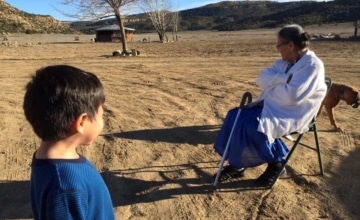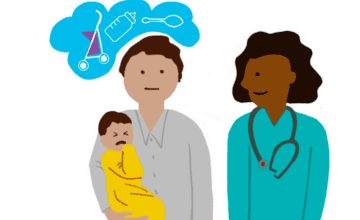Richard Sheward, Allison Bovell-Ammon, and Nayab Ahmad, Children's HealthWatch, Boston Medical Center, Boston Massachusetts
Genevieve Preer, Boston Medical Center, Boston Massachusetts
Stephanie Ettinger de Cuba, Boston University
Megan Sandel, Boston University, Boston Medical Center, Boston Massachusetts
Abstract
Within the health care sector, researchers, clinicians, and payers increasingly recognize the importance of the social determinants of health for improving maternal and child health. This article focuses on existing and emerging approaches to screening families for unstable housing circumstances. The authors describe how housing stability screening helps health care providers to better understand risks for caregiver and child health and wellness. They urge clinicians to screen more actively for housing stability, not just homelessness, hospitals to pursue incentive payments and alternative financial models to address housing instability, and policymakers to expand investments in housing as a health-promoting policy opportunity.
Unstable housing circumstances have been associated with a wide range of negative health outcomes, including lead exposure and toxic effects, asthma, and depression (Shaw, 2004). Housing instability is a social determinant of health variably defined by high housing costs relative to income, poor housing quality, unstable neighborhoods, overcrowding, and homelessness (Johnson & Meckstroth, 1998; Satcher, 2010). Additional metrics have included multiple moves; eviction; and difficulty paying rent, mortgage, or utilities (Geller & Curtis, 2010; Cutts et al., 2011; Gilman, Kawachi, Fitzmaurice, & Buka, 2003; Kushel, Gupta, Gee, & Haas, 2006; Pavao, Alvarez, Baumrind, Induni, & Kimerling, 2007; Stahre, VanEenwyk, Siegel, & Njai, 2015; Suglia, Duarte, Chambers, & Boynton-Jarrett, 2013). Children’s HealthWatch has previously examined health, developmental, and anthropometric correlates of housing insecurity among children younger than 3 years using crowding (> 2 people per bedroom or > 1 family per residence) and multiple moves (≥ 2 moves within the previous year) as indicators (Cutts et al., 2011). Our previous research also reported that infants whose mothers’ experienced homelessness prenatally had significantly increased adjusted odds of low birth weight compared to infants of mothers consistently housed and infants experiencing postnatal homelessness only (Cutts et al., 2015; Sandel et al., 2018b). We have also demonstrated that homelessness during infancy was associated with higher adjusted odds of fair or poor infant health and developmental risk, and higher adjusted odds of fair or poor health and depressive symptoms among homeless mothers (Cutts et al., 2018). Subsequent research from Children’s HealthWatch demonstrated the stress of prenatal and postnatal homelessness combined is associated with the greatest increased risk of adverse infant and early childhood health outcomes relative to those never homeless (March et al., 2011).
On the basis of our previous research and a review of the literature, in 2018 we identified distinct dimensions of housing instability associated with inadequate access to care and adverse health outcomes (Cutts et al., 2011; DeWit, 1998; Kushel et al., 2006; Simpson & Fowler, 1994). Our research found three specific housing circumstances: behind on rent in the past 12 months, two or more moves in the past 12 months, and history of homelessness in the child’s lifetime. Each circumstance was individually associated with increased odds of adverse caregiver and child health and material hardship (Sandel et al., 2018a). This article builds on our prior research and explores the current state of pediatric housing screening, the use of a three-question housing stability screen (the Housing Stability Vital Sign), and emerging future opportunities to better understand and promote caregiver and child health and wellness.
Why Should Health Care Screen for Housing Stability and Other Social Determinants of Health?
The United States spends increasingly more money per capita on medical care compared to other industrialized nations, while spending increasingly less on social services (Bradley & Taylor, 2013). While health-related social needs have historically been a concern for public health, social service, and religious and charitable organizations, the health care sector now recognizes its expanded role in identifying and addressing housing instability and other social needs. Increasingly, this rethinking of the role of health care leads states and institutions to squarely position the social determinants of health within, and not separate from, systems of health care delivery. Previous innovations and advances in pediatric practice and the patient-centered medical home have provided convincing evidence that screening for unmet basic social needs, including housing instability, is a necessary step to facilitating successful connections to community resources, with resulting improvements in health and well-being (Garg, Jack, & Zuckerman, 2013; Gottlieb et al., 2016). Housing stability screening provides important information for health care systems and communities, essential to decisions about program development and reimbursement rates.

Homelessness during infancy was associated with higher adjusted odds of fair or poor infant health and developmental risk, and higher adjusted odds of fair or poor health and depressive symptoms among homeless mothers. Photo: Pikul Noorod/shutterstock
How Should Health Care Providers Screen for Housing Stability in Clinical Settings?
Historically, there has been wide variation in how researchers and health care organizations develop, validate, and implement tools for identifying/addressing patients’ housing and other social needs (LaForge et al., 2018). This lack of standardized workflows/screening tools has largely resulted in ad hoc efforts to assess patients’ social needs with varying degrees of success and validation in terms of sensitivity, specificity, or evidence that outcomes are altered (Adler & Stead, 2015). The variation and lack of standard screening tools is due in part to the fact that no universally accepted definition of housing instability exists, and as a result, there is no national “gold standard” survey module (Coleman-Jensen, Gregory, & Rabbitt, 2017). Furthermore, though there is a great deal of research on housing quality, there is little research exploring different forms of housing instability compared side-by-side rather than in isolation from one another to identify associations with increased risk for adverse maternal and child health outcomes (Evans, Saltzman, & Cooperman, 2001; Krieger & Higgins, 2002). For this reason, we sought to develop a Housing Stability Vital Sign to accurately screen for a household’s housing stability and ultimately promote caregiver and child health and wellness.
Aside from the Housing Stability Vital Sign, other widely acknowledged screening tools exist. The Centers for Medicare & Medicaid Services (CMS) Accountable Health Communities Model screening tool asks two housing questions. The first housing question was adapted from the Protocol for Responding to and Assessing Patients’ Assets, Risks, and Experiences tool developed by the National Association of Community Health Centers and partners which was intended to identify patients who are homeless and are at risk of losing their housing for any reason, including inability to pay a mortgage or rent. The second housing question was adapted from a question developed by Nuruzzaman and colleagues which was intended to identify beneficiaries who are living in substandard housing (National Association of Community Health Centers, Association of Asian Pacific Community Health Organizations, Association OPC, & Institute for Alternative Futures, n.d.; Nuruzzaman, Broadwin, Kourouma, & Olson, 2015). The Boston Medical Center Health System’s ThriveTM screener asks patients a three-part housing question adapted from the CMS tool’s first housing question (Buitron de la Vega et al., in press).
While there is no agreed upon standard for screening for and assessing housing stability, previous research and current pilot projects have indicated the need to include questions that not only identify patients currently experiencing the most severe form of housing instability—homelessness—but also to identify patients and families experiencing instability that puts their health and well-being at risk.
The Housing Stability Vital Sign
Children’s HealthWatch developed the Housing Stability Vital Sign screening tool in the context of understanding the landscape of common housing questions used to screen for housing stability (i.e., homelessness and substandard housing) and of our previous research exploring various forms of housing instability (i.e., homelessness, overcrowding, multiple moves). We realized that a measure of affordability was missing and sought to examine potential associations with maternal and child health and well-being as well as other family social needs.
Research data we obtained from using a housing instability tool that included questions regarding being behind on rent, multiple moves, and homelessness confirmed that it was useful to ask about housing stability in clinical settings. For clinical sites interested in screening for housing stability, this research supported the use of three housing stability questions (as adapted from our Children’s HealthWatch research survey), which for consistency may best be asked in reference to the past 12 months:
a. Was there a time when you were not able to pay the mortgage or rent on time? (Answer is yes/no, positive screen if answer is yes);
b. How many places have you lived? (Answer is number of places lived, positive screen if answer is three or more, i.e. ≥ two moves in 12 months.); and
c. At any time were you homeless or living in shelter (including now)? (Answer is yes/no, positive screen if answer is yes)
When we compared unstably housed families who screened positive with the Housing Stability Vital Sign to families who were stably housed (after controlling for confounders), we found an association between each housing instability circumstance and adverse caregiver health outcomes, child health and development outcomes, and household hardships among families with children under 48 months old (Sandel et al., 2018a).
Limitations to the Housing Stability Vital Sign
First, as previously stated, because there is no agreed upon definition of circumstances that define housing instability, there is no gold standard housing stability screening against which these housing circumstances can be compared. For this reason, investments in future research to create robust standard testing of a diagnostic tool, such as sensitivity and specificity analysis, is warranted. Second, data used in the analyses included a large clinical sample of predominantly urban, low-income families of very young children and their primary caregivers. Although there is a strong link between poverty and housing instability, these housing circumstances have not been tested in populations of varying socioeconomic status, rural populations, or families without young children. Third, the cross-sectional design of the study demonstrates association, not causation, and we acknowledge that the associations (e.g., housing instability and maternal depressive symptoms) may be bi- or multi-directional. Finally, as with any self-report measure, these housing circumstances and some of the outcomes are subject to reporting bias and shared method variance. Despite these limitations, these three forms of housing stability have important clinical implications for all practitioners who work with children and families. Together, they represent an effective way to identify families at risk for adverse health conditions and hardships associated with unstable housing that can be administered in pediatric offices, by clinicians or practitioners working with young families in social service settings (e.g., departments of social services, school systems, housing assistance programs), or by housing and community groups to assess individual and community-level needs.
Experience at Boston Medical Center—Screening and Intervening in Housing Stability
At Boston Medical Center (BMC), New England’s largest safety-net hospital, screening for housing instability and for other social determinants of health has proven a critical first step in assessing the unmet resource needs that can contribute to poor health outcomes. The ThriveTM hospital-wide screening tool, which was implemented in the pediatric outpatient clinic in 2017, provides patients and families with the opportunity to report needs and request resources that might be of assistance in addressing these needs (Buitron de la Vega et al., in press). The Thrive tool is available in the six languages most commonly spoken in the hospital and assesses needs in eight areas: housing, food, utilities, medications, transportation, caregiving, employment, and education. For each of these areas, resource sheets are available within the electronic health record and can be easily printed and given to families during a visit. During the first year of screening in the pediatric outpatient setting, almost half of all families indicated at least one area of need, and 15% reported current housing instability or homelessness.
The practice of screening for housing insecurity and homelessness is an essential first step toward identifying families who are experiencing urgent or immediate housing needs. Ideally, screening can also provide an upstream opportunity to support families who are experiencing housing instability and can assist in making connections to resources to avert eviction and homelessness. By extension, when screening for needs in the areas in which financial stress may first become evident—difficulty paying for food and utilities, for example—appropriate referrals can support families in accessing resources that ideally can improve overall financial stability and help prevent housing instability and homelessness.
As indicated previously, neglecting to address the impact of social determinants of health generally, and housing specifically, stymies the provision of effective medical care. When screening tools identify housing instability or homelessness, however, it is incumbent upon those administering the screening to provide meaningful referral options to families who have trusted the medical team by sharing what may be very sensitive information about their housing needs.
At the same time, immense challenges face all service providers seeking to support families experiencing housing instability or homelessness. As in other metropolitan areas, families in Greater Boston face an extreme scarcity of affordable housing. Families seeking reasonable market-rate rental units may be forced to live far from their communities and workplaces or may have to double up or endure severely overcrowded conditions in order to maintain geographic proximity. Families who are homeless will enter an overburdened shelter system and may be placed in a distant facility without a realistic route to continuing in established school or employment.

Screening for unmet basic social needs, including housing instability, is a necessary step to facilitating successful connections to community resources. Photo: Monkey Business Images/shutterstock
In our clinical setting, addressing families’ reported housing needs involved developing an approach that prioritized collaboration between front-line staff, medical providers, and community-based organizations. We are fortunate to have strong longitudinal existing partnerships with two innovative organizations—Health Leads and MLPB (formerly known as Medical Legal Partnership | Boston). A new funding stream provided us with an opportunity to add a co-located housing specialist from Metro Housing | Boston, a nonprofit housing agency in Boston, to the care team.
Making appropriate and efficient referrals to the co-located housing specialist depended on effective collaboration between the many stakeholders in this equation. We laid the groundwork for this collaboration by first holding a series of meetings that included hospital-based patient navigators, family advocates, social workers, and other front-line staff who would be most likely to make referrals to the new housing specialist. These evolved into regularly scheduled meetings, or Housing Rounds, that provide an opportunity to build capacity in referring providers with regard to the complicated housing landscape in Greater Boston. Housing Rounds also function as a sounding board for complex cases, facilitate sharing of expertise from multiple perspectives, and provide a forum for brainstorming around barriers and challenges.
Another step in streamlining the process of making referrals was the development of a written referral pathway that could serve as a point of reference for deciding on when and how to make a referral. This document resulted from our first round of meetings and incorporated the input of partner organizations and service providers in order to troubleshoot commonly encountered questions and scenarios. We also developed a referral form, a release of information, and an information sheet to provide to families at the time of referral.
A final component of our approach was to train the medical team in the pediatric clinic on how to respond to positive screens for housing emergencies when support staff and community partners were not readily available to assist—during the weekend and evening clinic hours, for example. We created a simple referral algorithm outlining how to provide support and resources to families reporting a housing emergency with no place to stay that night. We provided training to all staff on this algorithm, including call center and front desk staff, medical assistants, nurses, nurse practitioners, and physicians.
Universal screening for housing and other resource needs in our clinical setting identified families at risk for eviction and homelessness whose needs might not have previously been recognized.
In summary, universal screening for housing and other resource needs in our clinical setting identified families at risk for eviction and homelessness whose needs might not have previously been recognized. The opportunity to offer families a referral to a housing specialist was a key component of being able to provide meaningful assistance in response to a positive screen. Collaboration with other partners in our clinical setting enhanced the reach of our referral process and built stronger working relationships between hospital staff and community organizations jointly working to address the formidable challenge of connecting families with stable, affordable housing.
Practice and Policy Considerations for Housing Stability Screening in Clinical Settings
Housing instability among low-income households raises numerous health care practice and policy concerns, namely its large contribution to inefficiencies within the U.S. health care system. For example, the top 5% of hospital users—overwhelmingly poor and housing unstable—are estimated to consume 50% of health care costs (Blumenthal & Abrams, 2016). A general lack of stable housing is a key driver behind the fact that households living in poverty in the U.S. are often the most expensive to treat. By identifying unstable housing in clinical settings, efforts designed to prevent family homelessness and improve housing stability can be extremely effective from both a public health and child development perspective. Moreover, the American Academy of Pediatrics recommended social screening within health care (Council on Community Pediatrics, 2016). We recommend practitioners screen patients for housing stability, document its prevalence and associated health risks in order to advocate for more resources, and drive innovations in addressing housing stability as a clinically important social determinant of health (Sandel et al., 2018a). Clinicians should more actively conduct housing stability screening, hospitals should pursue incentive payments and alternative financial models, and policymakers should expand investments in housing as a health-promoting policy opportunity.
Potential interventions include targeting homelessness prevention services for at-risk families (Shinn, Greer, Bainbridge, Kwon, & Zuiderveen, 2013); creating permanent, supportive housing initiatives aimed to reduce health care usage among the chronically homeless; and investing in housing production and services to respond to housing needs among patients (Gilmer, Stefancic, Ettner, Manning, & Tsemberis, 2010). For example, the Camden Coalition of Healthcare Providers in New Jersey and Hennepin County Health Center in Minnesota use housing vouchers to reduce health care costs; United Healthcare has invested in new housing across the country; Bon Secours Health System in Baltimore, Maryland, and Nationwide Children’s Hospital in Columbus, Ohio, have built affordable housing units; and Boston Medical Center in Boston, Massachusetts, has invested in a variety of affordable housing projects throughout Boston (McCluskey, 2017; Sandel & Desmond, 2017).
Outside of clinical settings, homelessness and housing instability assessments have been implemented by public health agencies as well as early care and learning settings, such as Head Start centers, child care centers, preschools, and family child care, to determine eligibility for programs and services (U.S. Department of Health and Human Services, 2016). For example, the Healthy Start in Housing (HSiH) program is a collaborative initiative of the Boston Public Health Commission and the Boston Housing Authority that helps housing-unstable, high-risk pregnant and/or parenting families, with a child under 5 years old who has a complex condition requiring specialty care, to secure and retain housing. The goals of HSiH are to improve birth outcomes and to improve the health and well-being of women and families. Key strategies include the provision of housing as well as intensive case management aimed at housing retention and participant engagement in services and interventions that contribute to achievement of their identified goals. Boston Public Health Commission helped determine eligibility and facilitated the intake process. It is worth noting among initiatives and interventions such as HSiH, and health care-based housing supports, that program eligibility may vary depending on the definition of housing instability or homelessness used (i.e., broader assessments of housing risk such as the Housing Stability Vital Sign, the McKinney-Vento definition of homeless, versus the very narrow definition of homelessness used by the U.S. Department of Housing and Urban Development).
Although there is much to learn from these promising efforts, they remain an outlier approach to improving patient health and are often limited in their scale due to inadequate funds as well as a narrow focus on highest-need, highest-cost patients, who are often adults. Children who are unstably housed in early life may form the pipeline to being the future high-need, high-cost adults. Thus continued research, innovation, and development of policies and programs are urgently needed.
Efforts that foster innovation and flexibility through the use of Accountable Care Organizations (ACOs) and Medicaid waivers can play an important role. One of the biggest investments in the field is the CMS innovation initiative of $157 million toward creation of the Accountable Health Communities Model (Alley, Asomugha, Conway, & Sanghavi, 2016). One promising aspect of this model is the use of “bridge organizations” tasked with the engagement of all the relevant service providers within a community (including health care services, public health, and social services) to achieve shared goals for a defined population (Billioux, Conway, & Alley, 2017). Funding for community service providers is a missing link in this model, and future efforts should ensure not just that the bridge exists but that the services provided are supported financially. At the state level, Massachusetts’ Medicaid 1115 waiver demonstration ACO program integrates a social needs screening measure into its ACO measure slate, which factors into an ACO’s quality score (Center for Health Care Strategies, 2018).
To significantly reduce health disparities through effective housing platforms, far more resources are needed. The Center for Health Care Strategies recently released a report that recommended CMS embrace adapted pay-for-success models, which would allow states and Managed Care Organizations to enable investments in addressing patients’ health-related social needs by paying only for “what works” (Center for Health Care Strategies, 2018). States and Managed Care Organizations could then invest in a portfolio of housing-based supports such as: legal assistance and payments that secure housing (i.e., one-time payment for security deposit and first month’s rent). In November 2018, U.S. Department of Health and Human Services Secretary Alex Azar suggested Medicaid may soon allow hospitals and health systems to directly pay for housing (Barr & Dickson, 2018). Yet ultimately, building healthier communities—with plenty of safe, decent, and affordable housing for all family configurations— will be required to improve the well-being of children who, if nothing changes, may be the future’s highest-need and highest-cost patients.
Learn More
Authors
Richard Sheward, MPP, is currently the deputy director of innovative partnerships at Children’s HealthWatch. Before joining Children’s HealthWatch, he completed an Education Pioneers Fellowship at Jobs for the Future, where he contributed directly to the organization’s policy research and analysis, and he supported the vice president in scoping out organizational strategy, resource development, and external relations. Richard has also focused on organizational development and fundraising as the grants manager for the Boston affiliate of the national youth development nonprofit America SCORES and as an AmeriCorps*VISTA member in New York to develop the startup operations and fundraising strategy for an eco-civic environmental justice program serving urban youth. Mr. Sheward received his bachelor’s degree cum laude from the University at Albany in English. He received his master’s of public policy from the Heller School at Brandeis University.
Allison Bovell-Ammon, MDiv, is currently the deputy director of policy strategy for Children’s HealthWatch. In her role, Allison leads the federal policy work of Children’s HealthWatch. She also co-leads (with Dr. Sandel) Housing Prescriptions as Health Care, an innovative project connecting high-health care utilizing families experiencing housing instability with services tailored to improve housing stability and health. Previously, Allison was the Boston site coordinator for Children’s HealthWatch where she supervised data collection in the Boston Medical Center Emergency Department before transitioning to the headquarters team as the research, policy and communications coordinator. Before joining Children’s HealthWatch, Allison worked with Drs. Frank and Rose-Jacobs’ on the Primary Care Enrichment Program research study at Boston University, which is a longitudinal study that explores the effects of in-utero substance use on the development of children. Allison has previously worked and volunteered with several direct-service nonprofit organizations. Allison received her bachelor’s degree magna cum laude from Birmingham-Southern College and master of divinity summa cum laude from Boston University School of Theology.
Nayab Ahmad is currently the administrative coordinator at Children’s HealthWatch. She has 5 years of experience in public health research and direct service. Previously, she was a patient advocate and in the Leadership Team at Health Leads, an organization that helps patients get access to basic resources like food and housing to improve their health. She also served as a research fellow for the Harvard Global Health Institute and a research assistant at Massachusetts General Hospital. Nayab received her bachelor’s degree from Harvard University.
Genevieve Preer, MD, is an assistant professor of pediatrics in Ambulatory Care Services at the Boston University School of Medicine. She is also a longtime pediatrician in the Child Protection Team at various universities in the Massachusetts area. She works as a care consultant and a case reviewer. Recently, she received the Excellence in Care Award from the Boston University Medical Group. Dr. Preer has served as a clinical supervisor for 15 medical students and as a co-leader for the Pediatric Subcommittee.
Stephanie Ettinger de Cuba, MPH, is the executive director for Children’s HealthWatch. Ms. Ettinger de Cuba is also part of Center for Research on Environmental and Social Stressors in Housing Across the Life Course contributing with several other team members to the HEAL project. She has co-authored more than 65 research and policy publications on a variety of subjects from food to housing to health care. Prior to joining Children’s HealthWatch, Ms. Ettinger de Cuba worked at Project Bread–the Walk for Hunger, a statewide anti-hunger organization in Massachusetts. There, she focused on SNAP (formerly food stamps) policy and outreach and was the evaluator and interim project director for USDA grants to develop and pilot Massachusetts’ first SNAP website and online application. Ms. Ettinger de Cuba previously worked for the Agricultural Health Study at the University of Iowa, College of Public Health and served as a Peace Corps volunteer in Bolivia focused on small-scale agriculture and nutrition and hygiene education. Ms. Ettinger de Cuba received her bachelor’s degree from the University of Michigan and her master’s degree in public health in international health from Boston University School of Public Health, where she is also currently a doctoral candidate in health services research.
Megan Sandel, MD, MPH, is the associate director of the GROW clinic at Boston Medical Center, a principal investigator with Children’s Health Watch and an associate professor of pediatrics at the Boston University Schools of Medicine and Public Health. She is the former pediatric medical director of Boston Healthcare for the Homeless program and is a nationally recognized expert on housing and child health. In 1998, she published, with other doctors at Boston Medical Center, the DOC4Kids report, a national report on how housing affected child health, the first of its kind, and, over the course of her career, Dr. Sandel has written numerous peer reviewed scientific articles and papers on this subject. In 2001, she became the first medical director of the founding site for medical-legal partnerships, Medical-Legal Partnership-Boston, and from 2007–2016 she served as the medical director of the National Center for Medical-Legal Partnership. She has served as a principal investigator for numerous National Institutes of Health, U.S. Department of Housing and Urban Development and foundation grants, working with the Boston Public Health Commission and Massachusetts Department of Public Health to improve the health of vulnerable children, particularly with asthma. She has served on many national boards, including Enterprise Community Partners, and national advisory committees at American Academy of Pediatrics and Centers for Disease Control and Prevention Advisory Committee for Childhood Lead Poisoning Prevention.
Suggested Citation
Sheward, R., Bovell-Ammon, A., Ahmad, N., Preer, G., Ettinger de Cuba, S., & Sandel, M. (2019). Promoting caregiver and child health through housing stability screening in clinical settings. ZERO TO THREE Journal, 39(4), 52–59.
References
Adler, N. E., & Stead, W. W. (2015). Patients in context—EHR capture of social and behavioral determinants of health. New England Journal of Medicine, 372(8), 698–701.
Alley, D. E., Asomugha, C. N., Conway, P. H., & Sanghavi, D. M. (2016). Accountable health communities—addressing social needs through Medicare and Medicaid. New England Journal of Medicine, 374(1), 811.
Barr, P., Dickson, V. (2018). CMS may allow hospitals to pay for housing through Medicaid. Modern Healthcare. Source
Billioux, A., Conway, P. H., & Alley, D. E. (2017). Addressing population health: Integrators in the Accountable Health Communities Model. JAMA, 318(19), 1865–1866.
Blumenthal, D., & Abrams, M. K. (2016). Tailoring complex care management for high-need, high-cost patients. JAMA, 316(16), 1657–1658.
Bradley, E., & Taylor, L. (2013). The American health care paradox: Why spending more is getting us less. New York, NY: Public Affairs.
Buitron de la Vega, P., Losi, S., Sprague Martinez, L., Bovell-Ammon, A., Garg, A., James, T., … Kressin, N. (in press). Implementing an EHR-based screening and referral system to address social determinants of health in primary care. Medical Care.
Center for Health Care Strategies. (2018). Addressing social determinants of health via Medicaid managed care contracts and Section 1115 demonstrations. Source link
Coleman-Jensen, A., Gregory, C., & Rabbitt, M. P. (2017). Survey tools. Source link
Council on Community Pediatrics. (2016). Poverty and child health in the UnitedStates. Pediatrics, 137(4), e20160339.
Cutts, D. B., Bovell-Ammon, A., Ettinger de Cuba, S., Sheward, R., Shaefer, M., Huang, C., …Frank, D. A. (2018). Homelessness during infancy: Associations with infant and maternal health and hardship outcomes. Cityscape, 20(2), 119–132.
Cutts, D. B., Coleman, S., Black, M. M., Chilton, M. M., Cook, J. T., Ettinger de Cuba, S., …Frank, D. A. (2015). Homelessness during pregnancy: A unique, time-dependent risk factor of birth outcomes. Maternal and Child Health Journal, 19(6), 1276–1283.
Cutts, D. B., Meyers, A. F., Black, M. M., Casey, P. H., Chilton, M., Cook, J. T.,… Frank, D. A. (2011). US housing insecurity and the health of very young children. American Journal of Public Health, 101(8), 1508–1514.
DeWit, D. J. (1998). Frequent childhood geographic relocation: Its impact on drug use initiation and the development of alcohol and other drug-related problems among adolescents and young adults. Addictive Behaviors, 23(5), 623–634.
Evans, G. W., Saltzman, H., & Cooperman, J. L. (2001). Housing quality and children’s socioemotional health. Environment and Behavior, 33(3), 389–399.
Garg, A., Jack, B., & Zuckerman, B. (2013). Addressing the social determinants of health within the patient-centered medical home: Lessons from pediatrics. JAMA, 309(19), 2001–2002.
Geller A. B., & Curtis M. A., & (2010). A longitudinal examination of housing hardships among urban fathers (Working Paper Number 1231). Source link
Gilman, S. E., Kawachi, I., Fitzmaurice, G. M., & Buka, S. L. (2003). Socioeconomic status, family disruption and residential stability in childhood:Relation to onset, recurrence and remission of major depression. Psychological Medicine, 33(8), 1341–1355.
Gilmer, T. P., Stefancic, A., Ettner, S. L., Manning, W. G., & Tsemberis, S. (2010). Effect of full-service partnerships on homelessness, use and costs of mental health services, and quality of life among adults with serious mental illness. Archives of General Psychiatry, 67(6), 645–652.
Gottlieb, L. M., Hessler, D., Long, D., Laves, E., Burns, A. R., Amaya, A., … Adler, N. E. (2016). Effects of social needs screening and in-person service navigation on child health: A randomized clinical trial. JAMA Pediatrics, 170(11), e162521.
Johnson, A., & Meckstroth, A. (1998). Ancillary services to support welfare-to-work. Princeton, NJ: Mathematica Policy Research.
Krieger, J., & Higgins, D. L. (2002). Housing and health: time again for public health action. American Journal of Public Health, 92(5), 758–768.
Kushel, M. B., Gupta, R., Gee, L., & Haas, J. S. (2006). Housing instability and food insecurity as barriers to health care among low-income Americans. Journal of General Internal Medicine, 21(1), 71–77.
LaForge, K., Gold, R., Cottrell, E., Bunce, A. E., Proser, M., Hollombe, C.,…Clark, K. D. (2018). How 6 organizations developed tools and processes for social determinants of health screening in primary care: An overview. The Journal of Ambulatory Care Management, 41(1), 2–14.
March, E., Ettinger de Cuba, S., Cook, J., Bailey, K., Cutts, D. B., Meyers, A. F., & Frank, D. A. (2011). Behind closed doors: The hidden health impacts of being behind on rent. Source link
McCluskey P. D. (2017). Boston Medical Center has a new prescription for its most vulnerable patients: Housing. Boston Globe. Source link
National Association of Community Health Centers, Association of Asian Pacific Community Health Organizations, Association OPC, & Institute for Alternative Futures. (n.d.). The Protocol for Responding to and Assessing Patients’ Assets, Risks, and Experiences (PRAPARE). Source link
Nuruzzaman, N., Broadwin, M., Kourouma, K., & Olson, D. P. (2015). Making the social determinants of health a routine part of medical care. Journal of Health Care for the Poor and Underserved, 26(2), 321–327.
Pavao, J., Alvarez, J., Baumrind, N., Induni, M., & Kimerling, R. (2007). Intimate partner violence and housing instability. American Journal of Preventive Medicine, 32(2), 143–146.
Sandel, M., & Desmond, M. (2017). Investing in housing for health improves both mission and margin. JAMA, 318(23), 2291–2292.
Sandel, M., Sheward, R., Ettinger de Cuba, S., Coleman, S., Frank, D. A., Chilton, M., … Cutts, D. (2018a). Unstable housing and caregiver and child health in renter families. Pediatrics, 141(2), e20172199.
Sandel, M., Sheward, R., Ettinger de Cuba, S., Coleman, S., Heeren, T., Black, M. M., … Rose-Jacobs, R. (2018b). Timing and duration of pre- and postnatal homelessness and the health of young children. Pediatrics, 142(4), e20174254.
Satcher, D. (2010). Include a social determinants of health approach to reduce health inequities. Public Health Reports, 125(Suppl 4), 6–7.
Shaw, M. (2004). Housing and public health. Annual Review of Public Health, 25, 397–418.
Shinn, M., Greer, A. L., Bainbridge, J., Kwon, J., & Zuiderveen, S. (2013). Efficient targeting of homelessness prevention services for families. American Journal of Public Health, 103(S2), S324–S330.
Simpson, G. A., & Fowler, M. G. (1994). Geographic mobility and children’s emotional/behavioral adjustment and school functioning. Pediatrics, 93(2), 303–309.
Stahre, M., VanEenwyk, J., Siegel, P., & Njai, R. (2015). Housing insecurity and the association with health outcomes and unhealthy behaviors, Washington State, 2011. Preventing Chronic Disease, 9(12), e109.
Suglia, S. F., Duarte, C. S., Chambers, E. C., & Boynton-Jarrett, R. (2013). Social and behavioral risk factors for obesity in early childhood. Journal of Developmental and Behavioral Pediatrics: JDBP, 34(8), 549, 549–556.
U.S. Department of Health and Human Services. (2016). Policy statement on meeting the needs of families with young children experiencing and at risk of homelessness. Source link





